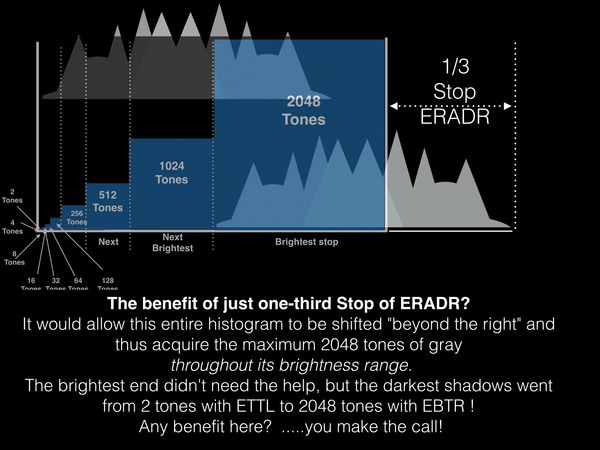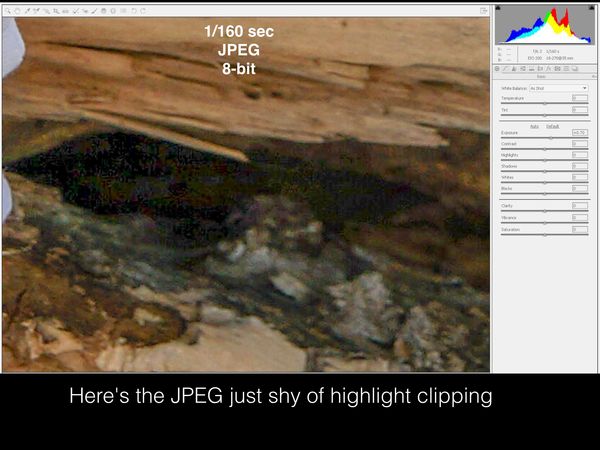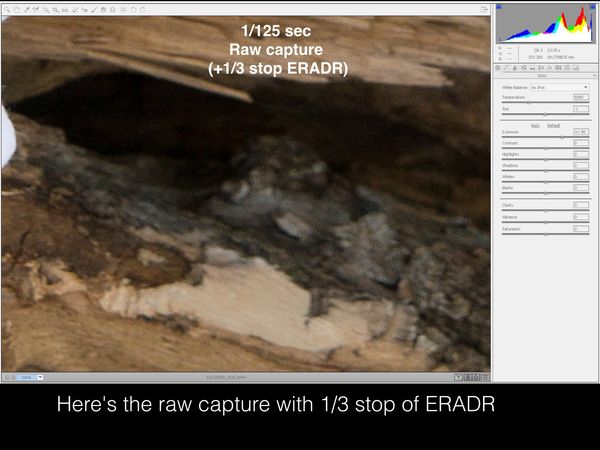Is EBTR worth it for 1/3 Stop ERADR?
Sep 11, 2015 10:07:44 #
A fair question: "My camera offers only 1/3 stop of Extra Raw-Accessible Dynamic Range (ERADR). That's not really worth the bother for EBTR (Expose Beyond the Right) is it?
We really need to think about how we visualize the RAW histogram compared with the JPEG-adjusted histogram frame seen in your camera's LCD screen.
Remember that the brightest stop can cover at least 50% of your image data...at least the right half of the histogram frame. Add a full stop of ERADR and you double the width of the histogram frame...and just one-third of that added dimension is actually a considerable addition to your ability to increase tonal spectrum and to increase SIGNAL:Noise ratio.
Unfortunately, the camera mfrs. haven't worked out how to display an accurate raw histogram as yet, so we're left with having to intelligently visualize it !
And remember, test your camera's ERADR at the ISOs you most often use. And yes, there are benefits to be gained even at higher ISOs.
See the graphic below and note the benefit gained re: tonal spectrum throughout the brightness range of the "light pile". Some shout that the bright end needs no further help with tonality...true, but the dark shadows, starting out with 2 tones of gray with ETTL under exposure certainly do benefit maximally from EBTR with 1/3 stop of ERADR !
Dave
We really need to think about how we visualize the RAW histogram compared with the JPEG-adjusted histogram frame seen in your camera's LCD screen.
Remember that the brightest stop can cover at least 50% of your image data...at least the right half of the histogram frame. Add a full stop of ERADR and you double the width of the histogram frame...and just one-third of that added dimension is actually a considerable addition to your ability to increase tonal spectrum and to increase SIGNAL:Noise ratio.
Unfortunately, the camera mfrs. haven't worked out how to display an accurate raw histogram as yet, so we're left with having to intelligently visualize it !
And remember, test your camera's ERADR at the ISOs you most often use. And yes, there are benefits to be gained even at higher ISOs.
See the graphic below and note the benefit gained re: tonal spectrum throughout the brightness range of the "light pile". Some shout that the bright end needs no further help with tonality...true, but the dark shadows, starting out with 2 tones of gray with ETTL under exposure certainly do benefit maximally from EBTR with 1/3 stop of ERADR !
Dave
Sep 11, 2015 10:19:07 #
Uuglypher wrote:
A fair question: "My camera offers only 1/3 s... (show quote)
1/3 stop? Hell, I'd take .1 stops. Anything to increase the quality of the original capture is a plus, no matter how small.
--Bob
Sep 11, 2015 12:34:53 #
rmalarz wrote:
1/3 stop? Hell, I'd take .1 stops. Anything to increase the quality of the original capture is a plus, no matter how small.
--Bob
--Bob
I love that "attytood", but alas...my ability ...hand-eye coordination...to move that "light pile" to the right the equivalent of +0.1 is sorely, regrettably, woefully, and sadly lacking...and I'm not at all sure I ever had it!
Dave
Sep 11, 2015 12:48:50 #
Uuglypher wrote:
I love that "attytood", but alas...my ability ...hand-eye coordination...to move that "light pile" to the right the equivalent of +0.1 is sorely, regrettably, woefully, and sadly lacking...and I'm not at all sure I ever had it!
Dave
Dave
Dave, the .1 was an exaggeration. It was meant only to convey my opinion of the value of knowing one's equipment well enough to advantageously use the total exposure range available.
--Bob
Sep 11, 2015 13:24:07 #
rmalarz wrote:
Dave, the .1 was an exaggeration. It was meant only to convey my opinion of the value of knowing one's equipment well enough to advantageously use the total exposure range available.
--Bob
--Bob
I figured as much...just a bit of levity...and self-pity.
Sep 11, 2015 13:38:51 #
Uuglypher wrote:
I figured as much...just a bit of levity...and self-pity.
Levity is great, and I enjoy it quite a bit. Sometimes I levitate, but in such a serious manner that people don't realize I'm levitating.
Self-pity, the jury is still out on that one.
--Bob
Sep 12, 2015 13:01:19 #
Quite frankly NO, 1/3 "stop" is not worth it. Any pic. worth agonizing over will be worth printing. And any worth printing will be worth being looked at. And any picture being worth looked at will be seen in a real gallery. And any pic seen in a real gallery will not be remembered as to its 1/3 EV when leaving the place. And any picture that is worth being in a gallery will be reproduced in a catalog or on some web site, and they'll blow your picky 1/3 EV all to 'ell.
Now you have your full answer, which is an 'ell of a lot to expect from a traditionally brought up reticent New Englander who might have just said "NO", and let you ask the next questions so you could learn slowly just why.
Now you have your full answer, which is an 'ell of a lot to expect from a traditionally brought up reticent New Englander who might have just said "NO", and let you ask the next questions so you could learn slowly just why.
Sep 12, 2015 13:35:53 #
jenny wrote:
Quite frankly NO, 1/3 "stop" is not wort... (show quote)
Jenny, that 1/3 stop might just be the difference between a gallery and languishing forever on a hard drive never to see the light of day.
--Bob
Sep 12, 2015 15:08:03 #
rmalarz wrote:
Jenny, that 1/3 stop might just be the difference between a gallery and languishing forever on a hard drive never to see the light of day.
--Bob
--Bob
* * *
Nah, it can always be fixed in post processing
:) :) :)
Sep 13, 2015 11:02:28 #
jenny wrote:
* * *
Nah, it can always be fixed in post processing
:) :) :)
Nah, it can always be fixed in post processing
:) :) :)
Sorry, Jenny,
You can't fill in the gaps of an expanded 8-bit image file in PP.
The noise you captured, as well as the scant shadow tonal spectrum are there forever!
Have a look at the benefit to be gained by using that "little 1/3 of a stop" of exposure.
That histogram, shot in 8-bit JPEG, has noise and restricted detail in the darker left portion.
That same image, captured in raw data by "Expose Beyond the Right" with 1/3 stop more exposure, is saved from the sad fate of noise and low detail in the darker portions. It's ENTIRE BRIGHTNESS RANGE now enjoys plenty of discernible detail as well as no noticeable noise!
That 1/3 stop can, indeed, make a big difference!
Dave
Compare for Noise and shadow detail
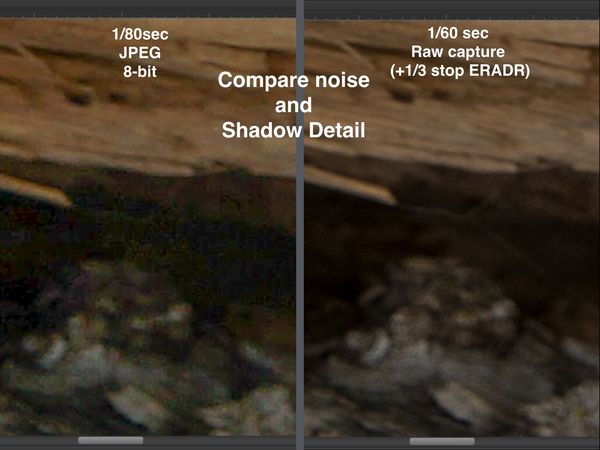
(Download)
Improved histogram position permitted by EBTR Improved histogram position permitted by EBTR WITH 1/3 stop addition; darkest region now has 1024 tones of gray!
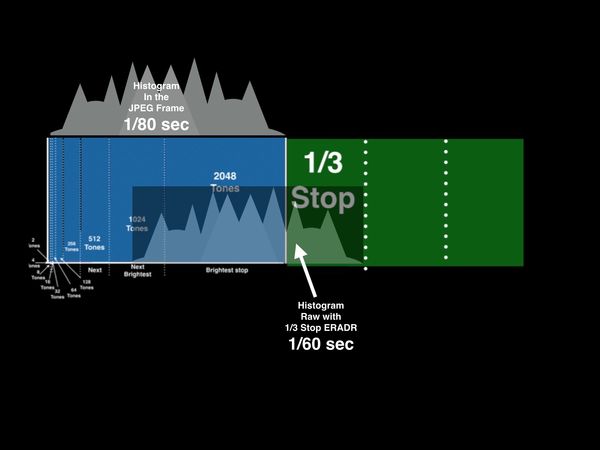
(Download)
Sep 13, 2015 12:57:17 #
Uuglypher wrote:
,..to move that "light pile" to the right the equivalent of +0.1 is sorely, regrettably, woefully, and sadly lacking...and I'm not at all sure I ever had it! Dave
If you ask Apaflo I'm sure he can tell you how to do it since he has claimed that he can measure and set exposure that closely.
Seriously, no. A 1/3 stop change is not going to be something that you will be able to see and you will not be able to measure the "improvement" in the final image. It will also be very hard to confirm on the camera's histogram.
At the exposure stage you are only looking at improving the information in the raw image. But 1/3 stop of exposure is not significant, even for a hypothetical image. It just increases the potential for blown highlights a tiny bit more. And it only reduces noise by about 1 dB and you can't see that either.
The real work is going be the effort you make to recover the highlights and shadows (if you want to) from the raw image as you process it into something visible.
Sep 13, 2015 14:12:17 #
No question that the camera's histogram is woefully lacking in rendering a 1/3 stop difference, but, happily, we don't need it for that.
When we know our camera's accuracy of "clipping point" we can accurately add ERADR stops in accurate steps of 1/3.
This was done with the examples shown, and the diagram explains the differences displayed based on right-ward displacement of the left end of the histogram /"light pile" away from the Mother lode of noise (in the left third of the JPEG histogram frame) and extremely low tonal spectrum into the second brightest stop's realm of 1024 tonal steps of spectrum.
Even in your computer display the differences in noise as well as tonal spectra should be able to be seen ( be sure to view download). In prints made with reasonable skill, the advantage of one-third stop of ERADR under circumstances such as this is clearly obvious.
The concern that it ".. just increases the potential for blown highlights a tiny bit more" is the common worry of the beginner with Exposure Beyond the Right. At least with Adobe Camera Raw as the raw converter, and with experience with the camera used, that concern is minuscule.
The claim was made that: "The real work is going be the effort you make to recover the highlights and shadows (if you want to) from the raw image as you process it into something visible." Such claims of much arduous pp work are likewise vastly overstated by those inexperienced with EBTR.
The differences in data quality (S:N /noise, and tonal spectra) should be easily appreciable in the example posted, but I agree that if one's intent is simply on-line image display, one probably wouldn't have sufficient concern to worry about the 1/3 stop.
But in the print it's another story entirely.
Dave
When we know our camera's accuracy of "clipping point" we can accurately add ERADR stops in accurate steps of 1/3.
This was done with the examples shown, and the diagram explains the differences displayed based on right-ward displacement of the left end of the histogram /"light pile" away from the Mother lode of noise (in the left third of the JPEG histogram frame) and extremely low tonal spectrum into the second brightest stop's realm of 1024 tonal steps of spectrum.
Even in your computer display the differences in noise as well as tonal spectra should be able to be seen ( be sure to view download). In prints made with reasonable skill, the advantage of one-third stop of ERADR under circumstances such as this is clearly obvious.
The concern that it ".. just increases the potential for blown highlights a tiny bit more" is the common worry of the beginner with Exposure Beyond the Right. At least with Adobe Camera Raw as the raw converter, and with experience with the camera used, that concern is minuscule.
The claim was made that: "The real work is going be the effort you make to recover the highlights and shadows (if you want to) from the raw image as you process it into something visible." Such claims of much arduous pp work are likewise vastly overstated by those inexperienced with EBTR.
The differences in data quality (S:N /noise, and tonal spectra) should be easily appreciable in the example posted, but I agree that if one's intent is simply on-line image display, one probably wouldn't have sufficient concern to worry about the 1/3 stop.
But in the print it's another story entirely.
Dave
Sep 13, 2015 14:47:31 #
Uuglypher wrote:
... This was done with the examples shown, and the diagram explains the differences displayed based on right-ward displacement of the left end of the histogram /"light pile" away from the Mother lode of noise ...
Increasing exposure to move the right end of the histogram to the right is accomplished by a proportionate increase in exposure across all tonal values. Moving one full stop to the right doubles the exposure for all zones. This does not mean that the entire histogram moves to the right in lock-step. There will be a significant change in its shape and you may see the peaks and valleys on the right move further than those on the left. This is especially true of there is a significant portion of the scene in the shadows. But with a normal outdoor scene, the initial un-compensated exposure may not result in a histogram that touches either end of the scale.
There really is no "mother load" of noise at the left end of this histogram if you are already set to base ISO and the dynamic range of the scene is fairly normal, i.e., around 5-6 zones and your camera has a fairly decent dynamic range and low noise at base ISO.
But if the opposite is true (your ISO is high, the scene has a high dynamic range, your camera is noisy and has a low dynamic range to begin with) then you must employ ETTR/EBTR to its limit and convert the raw image with care.
Sep 13, 2015 16:05:53 #
selmslie wrote:
Increasing exposure to move the right end of the h... (show quote)
Thanks for looking and for your comments.
The camera's DR IS 14 EV. and the scene's Dr was close to that. The JPEG exposure was within 1/3 stop of clipping. After making the JPEG exposure I switched to RAW, added 1/3 stop (slower shutter) of ERADR and made the raw capture. I am pleased with the absence of noise and discernibly improved shadow detail with the EBTR exposure. Tonal normalization of the EBTR FILEis the labor of a few seconds. You and I seem to have different thresholds regarding image data quality and "necessary labor"
Each to his own.
Sorry, meant to mention that the ISO was 200, aperture f/6.3, 1/80 sec(JPEG) and 1/60 sec. (EBTR raw)
Thanks, again, Scotty, for looking and for your comments.
I'll be interested in any comments others may offer.
Dave
Sep 13, 2015 20:52:25 #
Uuglypher wrote:
Thanks for looking and for your comments. br The c... (show quote)
Hi, Scotty,
I was in the process of running an ERADR series on a camera I hadn't checked for over three years, and in the process saw that it was a good opportunity to demo the usefulness of 1/3. stop of ERADR. I checked the ETTR exposure for JPEG, and have compared it with the raw data captured with 1/3 stop longer exposure. (When checking the exposures I realized my memory re: exposure had been faulty . I am posting the crops of shadow detail along with the histograms and exposures so there is no misunderstanding.)
It is, I think, a good example of the utility of even a 1/3 stop of ERADR. It is necessary to realize that moving the "light pile"/histogram as far as possible to the right into the 1/3 stop of ERADR permits it's dark end to "come along into the light" and leave behind the less-well exposed stops with their attendant low S:N (and noise) and their l ow tonal spectra. It's not an image I'd print, but this comparison well illustrates the value of even just1/3 stop of exposure in improving image data quality.
Dave
I
If you want to reply, then register here. Registration is free and your account is created instantly, so you can post right away.

